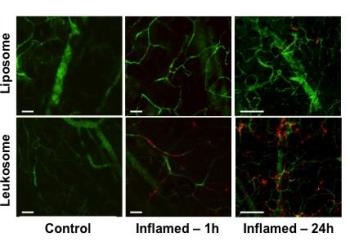May 25 2016
Nanosized Trojan horses formed from a patient’s immune cells have overcome the body’s complex defense mechanisms and effectively treated inflammation, potentially paving the way for broader applications for treating inflammatory diseases, like cardiovascular diseases and cancer.
 IVM images of inflamed-vasculature targeting. Compared with control liposomes, leukosomes showed a five-fold and eight-fold increase in accumulation at one hour and 24 hours after particles' injection, respectively. (Credit: Houston Methodist)
IVM images of inflamed-vasculature targeting. Compared with control liposomes, leukosomes showed a five-fold and eight-fold increase in accumulation at one hour and 24 hours after particles' injection, respectively. (Credit: Houston Methodist)
An international group, headed by scientists from the Houston Methodist Research Institute, explained the development of nanoparticles called leukosomes and analyzed their capability to treat localized inflammation in Nature Materials journal.
The latest approach to treat diseases characterized by inflammation have not been successful, as a previously overactive immune system treats nanoparticles as foreign invaders and removes them from the body, preventing them from reaching their intended target.
A better approach for building effective drug delivery platforms is to find inspiration for their design in the composition of the immune cells of our body. Immune cells such as leukocytes freely circulate in blood vessels, recognize inflammation, and accumulate in inflamed tissues. They do so by using special receptors and ligands on their surface. We purified leukocytes from a patient, then integrated their special ligands and receptors into the leukosome surface. Using the body’s own materials, we built a drug delivery system camouflaged as our own body’s defense system—thus the Trojan horse.
Ennio Tasciotti, Ph.D., Director of the Center for Biomimetic Medicine, Houston Methodist Research Institute
Acute inflammation in its normal form is an important and advantageous part of the body’s defense mechanism against infection, but under some conditions inflammation could turn into a vicious enemy, destroying or damaging healthy cells. The same can occur with autoimmune disorders like lupus, rheumatoid arthritis and inflammatory bowel disease, or in diseases like cardiovascular disease, cancer, Type 2 diabetes, and Alzheimer’s.
Leukosomes are capable of targeting inflamed tissues as they maintain similar surface properties of the immune cell membranes from which they are produced. In order to assess effectiveness of leukosomes as drug carriers, Tasciotti and his co-workers developed vesicles from mouse leukocytes and packed them with an anti-inflammatory agent, dexamethasone (DXM).
We used ‘personalized’ DXM-loaded leukosomes to treat inflammation in mice. After administering the leukosomes, we observed their attachment to the surface of blood vessels surrounding the inflamed tissue, and they selectively delivered DXM to the affected cells.
Ennio Tasciotti, Ph.D., Director of the Center for Biomimetic Medicine, Houston Methodist Research Institute
The treated mice displayed clear signs of progress, including inflammation resolution, a major decrease in tissue thickness, and an immune response reversal that is generally observed in inflammation.
According to Tasciotti, encouraging results were obtained from the group’s preliminary leukosome trial and proposed that membranes purified from different types of cells can also be utilized as biomimetic nanocarriers for treating various other diseases.
By combining cell biology with nanotechnology, we can create valuable medical tools that work within, and not around, the laws of nature.
Ennio Tasciotti, Ph.D., Director of the Center for Biomimetic Medicine, Houston Methodist Research Institute
The study was funded by the National Institutes of Health (1R21CA173579-01A1 and 5U54CA143837 PSOC Pilot project), the Department of Defense (W81XWH-12-10414 BCRP Innovator Expansion), George J. and Angelina P. Kostas Charitable Foundation, The Brown Foundation Inc., William Randolph Hearst Foundation, and The Cullen Trust for Health Care.
The scientists who teamed up with Tasciotti on the Nature Materials paper are: Roberto Molinaro, Claudia Corbo, Jonathan O. Martinez, Francesca Taraballi, Michael Evangelopoulos, Silvia Minardi, Picheng Zhao, Enrica De Rosa, Naama E. Toledano Furman, Xin Wang and Alessandro Parodi (Houston Methodist Research Institute, Houston, Texas); and Michael Sherman (University of Texas Medical Branch, Galveston, Texas). Corbo, Taraballi and De Vita are also the staffs of research institutions in Italy.
Nature family of journals division is Nature Materials and its impact factor is 36.5.